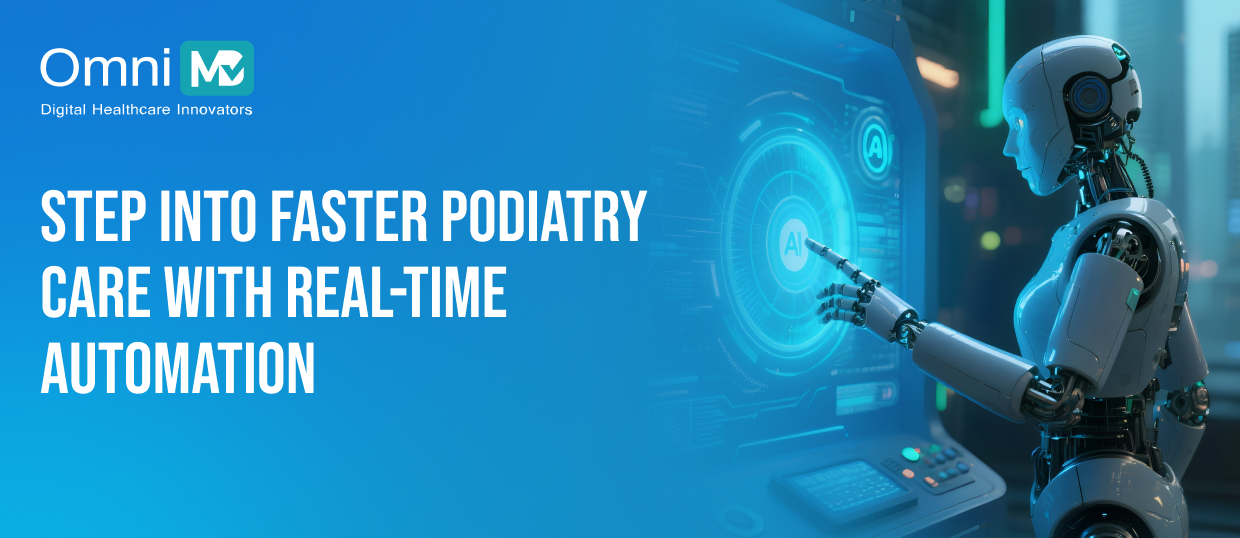How Speech Recognition and Mobile EHR Improve Podiatry Office Efficiency?
What happened to my day?
If you’ve ever spent enough time in a podiatry clinic, you have likely noticed how your day disappears into micro-tasks that your residency never prepared you for.
Whether it is a solo practice in rural Ohio or a six-provider foot and ankle group in Phoenix, the pattern repeats. Documentation time rises sharply after every procedure, nail avulsions, callus or wound debridements, and injections.
As an EHR consultant who spent more than two decades working exclusively with podiatrists tracked this moment across 22 practices, we measured documentation time when four factors occurred together: bilateral symptoms, procedures, photo-based exams, and biomechanical assessments for new patients. The data showed striking consistency.
Differences between cases came from timing rather than diagnosis or clinical complexity. Efficiency dropped as soon as the provider moved from examination to documentation. The transition itself created the delay. Physical motion gave way to clicking, and clinical flow broke into fragments of data entry.
Every discussion of podiatry efficiency begins with this measurable pause inside the workflow. The pause occurs dozens of times each day, shaping how providers move, think, and record. Two technologies remove that pause completely: speech recognition and mobile EHR systems.
Let’s see how.
Understanding Speech Recognition in Podiatry: What It Is And Why It Works Better Here Than in Any Other Specialty
But before we talk about AI scribes or mobile EHRs, we need clarity about:
What Exactly Is Speech Recognition?
Speech recognition is the technology that turns spoken podiatry-specific language, like ‘Performing partial nail avulsion on the medial border of hallux, right foot’, into structured digital documentation. But what makes it uniquely powerful in podiatry are:
A. Predictable Clinical Narratives
Podiatry involves recurring cases:
- Heel pain
- Ingrown nails
- Diabetic foot ulcers
- Neuropathy
- Bunions and hammertoes
- Ankle sprains
- Wound care follow-ups
- Orthotic adjustments
Because these patterns repeat, speech recognition models can be finely tuned for:
- Shorter narration
- Quicker phrasing
- Higher accuracy
- Specialty-specific templates
B. Repetitive Exam Structures
Podiatric documentation often follows a consistent flow:
- Vascular
- Neurologic
- Dermatologic
- Musculoskeletal
- Orthopedic
- Biomechanics
Speech recognition can auto-map these sections when podiatrists say:
‘Normal vascular, diminished protective sensation on right plantar forefoot. Positive Tinel’s at the tarsal tunnel.’
C. Procedure-Dense Visits
Lots of podiatry visits include procedures:
- Nail debridement
- Avulsion
- Matrixectomy
- Callus paring
- Wart treatment
- Injections
- Wound debridement
Speech recognition speeds these up dramatically because procedural documentation is template-heavy.
D. Foot-Specific Anatomical Terminology
Speech recognition has become remarkably good at picking up podiatry terms like:
- ‘Lisfranc’
- ‘Plantar plate tear’
- ‘Hallux valgus interphalangeus’
- ‘Metatarsalgia’
- ‘Morton’s neuroma’
This wasn’t true 10 years ago.
E. Dictation Happens Where Hands Are Busy
Because podiatrists frequently hold instruments, apply dressing, or palpate structures, speech recognition enables hands-free charting during these encounters.
The Podiatry Application of Speech Recognition: AI Scribe, AI Front Desk & AI Clinician Tools
Now that we’ve defined speech recognition, let’s explore how modern podiatry practices actually use it.
- AI MEDICAL SCRIBE FOR PODIATRY
An AI scribe built for podiatry understands:
- Foot-specific exam language
- Procedure workflows
- Orthotic conversations
- Chronic care conditions like neuropathy or Charcot foot
- Wound care descriptions
- Gait/balance discussions
- Nail care for at-risk patients
| How It Works In a Real Podiatry Ecosystem
Imagine you walk into the room for a diabetic with chronic plantar ulcer under the 1st met head.
You speak naturally:
“We’ve got a Wagner Grade 1 ulcer, plantar sub-met one. No purulence. No bone exposure. I’ll sharply debride devitalized tissue today.”
The AI scribe automatically:
- Builds the ulcer note
- Codes the debridement
- Generates a podiatry-specific treatment plan
- Captures wound dimensions
- Adds ICD-10 (L97.511 or similar)
- Prepares foot photos for upload
No need to say, “Insert into plan,” or “Start a new note.”
For Acute Foot Pain
If you say:
“Classic plantar fasciitis of the right foot. Pain worst in morning. I’m doing corticosteroid injection today.”
The AI recognizes:
- Condition
- Location
- Laterality
- Procedure performed
- Plan (stretching, NSAIDs, orthotics, footwear)
For Nail Issues
“Medial border ingrown nail right hallux, inflamed, performing partial avulsion.”
AI understands:
- Nail margin
- Side
- Toe
- Procedure
- Follow-up
Efficiency Gains
A podiatry AI scribe:
- Cuts note time by 70–90%
- Reduces after-hours charting dramatically
- Eliminates the need for manual transcription
- Improves coding accuracy for procedures
- Helps avoid audits in wound care and nail care by improving documentation alignment with Medicare rules
- AI FRONT DESK FOR PODIATRY
AI at the front desk uses speech/voice recognition differently, here it handles:
- Appointment scheduling
- Orthotic benefit verification questions
- Diabetic foot care eligibility queries
- Questions about nail procedures (“Is it covered?”)
- Follow-up wound care scheduling
- Sports injury triage
| How It Works In a Real Podiatry Ecosystem
For Heel Pain Patients If You Say:
“I need an appointment for heel pain. I’ve had it for weeks.”
AI replies and schedules with diagnosis-specific slot durations.
For Nail Care:
“Do you treat ingrown toenails?”
AI provides procedure details, prep instructions, and triage urgency.
For Diabetic Shoe Program:
“What paperwork do I need for diabetic shoes?”
AI explains Medicare requirements and schedules necessary evaluations.
Efficiency Gains
- Cuts inbound call volume by 40–60%
- Eliminates routine phone tasks
- Improves new-patient conversion (foot pain patients get fast scheduling)
- Reduces hold time for orthotic queries
- Frees receptionists for in-clinic tasks (like orthotic scanning)
- AI CLINICIANS FOR PODIATRY
AI clinician assistants, powered by speech recognition, help podiatrists:
- Review X-ray findings
- Summarize EMR history
- Suggest procedure codes
- Compare wound photos over time
- Track orthotic ordering patterns
- Recommend care pathways for chronic podiatry conditions
| How It Works In a Real Podiatry Ecosystem
Say:
“Show me last year’s wound photo for this foot.”
AI pulls exact image.
Or:
“Suggest differential diagnoses for lateral foot pain after inversion.”
AI would list:
- Peroneal tendon strain
- Cuboid syndrome
- Fifth metatarsal avulsion fracture
- Sinus tarsi syndrome
AI clinician tools also summarize long chart histories, particularly useful for chronic heel pain or longstanding neuropathy.
But even the best speech-recognition AI cannot reach its full potential if the EHR underneath it is slow, click-heavy, or built for desktop-only workflows.
This is exactly where many podiatrists hit a ceiling.
After every improvement in speech recognition came the same complaint:
“Why am I still losing time inside the EHR?”
This gap is what pushed the industry from traditional desktop EHRs to mobile-first podiatry EHR systems.
And nobody explains this shift better than the podiatry informatics veterans who lived through these transitions.
That brings us to a deep narrative comparison between desktop and mobile EHR efficiency. Let’s dive in.
20-Years Legacy of Podiatry EHR Specialist: A Deep Narrative Comparison Between Desktop and Mobile EHR Efficiency
Meet ‘Dr. Giri’: A Podiatry EHR Expert for 20+ Years
For 12+ years, Dr. Girirajtosh Purohit has helped podiatrists transition from paper charts:
- to desktop EHR
- to cloud systems
- to mobile workflows
- to today’s AI-powered podiatry EHR ecosystem.
Here’s how he shares this perspective.
- ‘Desktop EHR Was Never Built for How Podiatrists Work.’
Desktop systems assumed:
- Long encounters
- Desktop workspace
- Two-handed typing during care
But podiatrists work in fast, procedure-heavy, equipment-filled rooms.
Dr. Giri says:
“Desktop EHR slowed the average podiatrist down by at least 30%. It required too many clicks, too many windows, too many templates that didn’t match podiatry workflows.”
Examples:
- Entering wound dimensions
- Documenting bilateral findings
- Adding procedure orders
- Managing orthotic notes
- Uploading foot photos from cameras
Desktop EHRs required manual typing, keyboard shortcuts, and slow navigation.
- How Mobile EHR Changed Podiatry Efficiency at the Visit Level
Mobile EHR solved specific podiatry workflow barriers:
Instant Foot Photo Capture
No more SD cards, email transfers, or separate folders.
Podiatrists now take photos on a mobile device and auto-attach to the exact encounter.
Dictating During Care
While trimming a dystrophic nail or applying a dressing, the provider can speak:
“Debridement of onychomycosis nail plates 1 through 5 bilaterally completed.”
The mobile EHR captures it instantly.
Tap-to-Code for Procedures
Instead of searching CPT codes, podiatrists tap preset procedure buttons:
- 11055
- 11721
- 28119
- 20550
- 97597
- 73630
Gait and Orthotic Notes
Mobile EHR lets podiatrists quickly:
- Record gait observations
- Capture orthotic modifications
- Document shoe gear assessments
- Attach scanning files
Wound Care Templates on Tap
Wound care is the hardest podiatry documentation area.
Mobile EHR makes it simpler:
- Auto-detects past measurements
- Tracks improvement
- Generates MIPS-required documentation
C. Real Efficiency Gains: Desktop vs. Mobile EHR in Podiatry
Finding#1: Exam Room Time Shrinks by 5 to 7 Minutes Per Visit
Because podiatry visits are short (~12 min), this is a massive gain.
Finding #2: Procedure Documentation Accuracy Improves by 40 to 70%
Especially for routine foot care, wound care, and injections.
Finding #3: After-Hours Documentation Drops 60 to 80%
Mobile EHR + speech dictation allows podiatrists to finish charts in-room.
Finding #4: Front Desk Dependencies Drop
Mobile EHR empowers the provider to:
- Check insurance
- Verify DME needs
- Adjust orders instantly
Finding #5: Billing Accuracy Goes Up
Desktop errors occur when clicking wrong diagnosis or laterality.
Mobile systems reduce this dramatically.
Finding #6: Procedural Photos Come with Automatic Timestamping
Critical for audits.
Finding #7: Overall Practice Revenue Increases by 15 to 25%
Because podiatrists can see:
- 3–5 more patients/day
- Higher documentation accuracy
- Faster coding turnaround
How Speech Recognition And Mobile EHR Together Transform Podiatry Efficiency
When combined, these technologies create an entirely new podiatry workflow.
You Walk Into the Room
Mobile EHR pulls up patient chart based on proximity.
You Start Speaking During Care
Speech AI captures all clinical details.
AI Scribe Builds the Full Podiatry Note
SOAP + procedure + coding + plan.
You Capture Foot Photos Instantly
Auto-attached. Auto-geo-tagged.
You Tap Procedures Instead of Typing Codes
Boost accuracy.
Front Desk AI Schedules Follow-Ups Automatically
Wound care at 2 weeks
- Orthotic fitting
- Nail check
- Imaging
- Surgery consult
Chart Is Closed Before You Leave the Room
This is the dream podiatrists have wanted since the early 2000s, and it’s finally real.
The Next Era of Podiatry Efficiency Is Hands-Free, Mobile, and AI-Driven
For decades, podiatrists have accepted inefficiency as part of the job. Long after-hours charting, repetitive documentation, slow desktop EHRs, and front-desk bottlenecks. But today, the combination of speech recognition, AI scribing, mobile EHR workflows, and AI-powered front-office automation finally eliminates the hidden pauses that used to define a podiatry workday.
Where the desktop era forced providers to stop, click, type, and navigate, the mobile + AI era allows them to move, speak, and document naturally, right inside the exam room.
Where traditional EHR slowed a podiatrist’s clinical flow, speech recognition and mobile tools now adapt to the rhythm of podiatry itself: procedures, photos, gait assessments, orthotic adjustments, wound care, and high-volume visits.
Podiatry is finally entering a model where the technology moves with them.
Hands remain on the patient, eyes remain on the pathology, and documentation simply happens in the background.
In this new ecosystem, podiatrists don’t adapt to the EHR.
The EHR adapts to the podiatrist.

Boost Podiatry Efficiency with Smarter Documentation
See how speech recognition and mobile EHR streamline charting and patient flow.

 Written by Divan Dave
Written by Divan Dave